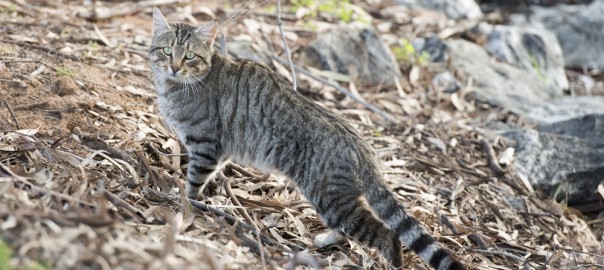What is a feral cat?
A feral cat is a cat who is born in the wild and has never known human contact. Feral cats flee, belly to the ground, when approached by potential predators. It is customary for feral cats to live together in a colony with a hierarchical structure. Typically, the colony is self sustaining and deters newcomers from the outside. Occasionally, stray cats wander in and either become accepted or are ostracized.
A stray cat, by contrast, is one who has had human contact but has been rendered homeless. Stray cats who have been homeless for a long time often revert to feral behavior, but can sometimes be tamed again if the duration of homelessness has not been terribly long or difficult. This duration, however, varies depending upon the personality of the particular cat. Most cats, feral or domesticated, learn to trust humans when the cats are between 6 and 12 weeks of age. Many who work at taming feral cats consider this the critical window in which to work with kittens for optimal results in making them adoptable.
How did they come to be?
Feral cats were the first cats, considered wildlife, before humans domesticated them for the purposes of rodent control and companionship. As domesticated cat populations grew, so did the numbers that became expendable. Such cats soon learned to live on the streets, and had litters, who bore litters, and feral cats once again prevailed. Unchecked, this population of feral and stray cats, it is estimated, makes up an entire 50% of the total cat population of the United States today, between 60 and 100 million cats, according to Alley Cat Allies, a Washington, DC based nonprofit.
What can be done about it?
Fifteen years ago, Alley Cat Allies founders Becky Robinson and Louise Holton began trapping feral cats using a European method called Trap-Neuter-Return (TNR) in the United States. Since their humble beginnings, Alley Cat Allies has become the cornerstone of the TNR movement providing education and outreach services to thousands of trappers throughout the United States and abroad. The basic premise of TNR is that it is the only method that is effective in curbing the rampant growth of feral cat colonies. Euthanizing the population is ineffective because it is impossible (and highly cost prohibitive) to catch them all, and those that remain merely initiate a massive breeding cycle that fills the vacuum in just a few years. TNR at least stops the endless progeny without altering the present numbers, therefore no breeding cycle is needed since no vacuum has been created. In addition, it is far more humane.
What does MAC do to help?
MAC is about forging connections with other rescue groups and working together, knowing that united we can do more. The Massachusetts Animal Coalition is highly supportive of the TNR method and created a task force to address feral cat concerns. The MAC Feral Cat Task Force funded the cost of spaying/neutering the first 640 cats at the Sunday Feral Cat Spay/Neuter Free Clinic program run by the Merrimack River Feline Rescue Society. MAC has held spay/neuter clinics at the MAC Clinic at Cummings School of Veterinary Medicine at Tufts University in Grafton and currently funds programs that support TNR through the Spay/Neuter License Plate Program.
How can I learn more?
To learn more, just click on a picture to go to any of the following web sites listed below. Additionally, here are links to a few additional resources:
- Shelter options for feral cats
- HSUS Overview for caring for feral cats
- www.masscats.org
- Alley Cat Allies
The groups below, large and small, have educational information about helping feral and stray cats, and offer their services as well.





